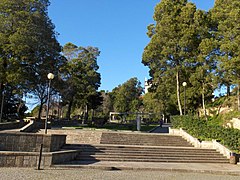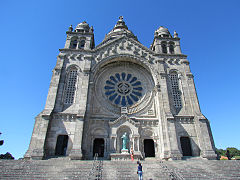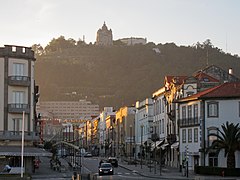world.wikisort.org - Portugal
Viana do Castelo (Portuguese pronunciation: [viˈɐnɐ ðu kɐʃˈtɛlu] (![]() listen)) is a municipality and seat of the district of Viana do Castelo in the Norte Region of Portugal. The population in 2011 was 88,725,[1] in an area of 319.02 km².[2] The urbanized area of the municipality, comprising the city, has a population of approximately 36,148 inhabitants, although the extended densely populated region reaches surrounding municipalities like Caminha and Ponte de Lima with a population above 150,000 inhabitants. It is located on the Portuguese Way path, an alternative path of the Camino de Santiago, and at the mouth of the Lima river.
listen)) is a municipality and seat of the district of Viana do Castelo in the Norte Region of Portugal. The population in 2011 was 88,725,[1] in an area of 319.02 km².[2] The urbanized area of the municipality, comprising the city, has a population of approximately 36,148 inhabitants, although the extended densely populated region reaches surrounding municipalities like Caminha and Ponte de Lima with a population above 150,000 inhabitants. It is located on the Portuguese Way path, an alternative path of the Camino de Santiago, and at the mouth of the Lima river.
Viana do Castelo | |
|---|---|
Municipality | |
Panoramic, Santa Lucia Church, Republic Square, Sé Cathedral, Fountain | |
 Flag  Coat of arms | |
 | |
| Coordinates: 41°42′N 8°50′W | |
| Country | |
| Region | Norte |
| Intermunic. comm. | Alto Minho |
| District | Viana do Castelo |
| Government | |
| • President | Luís Nobre (PS) |
| Area | |
| • Total | 319.02 km2 (123.17 sq mi) |
| Elevation | 12 m (39 ft) |
| Highest elevation | 825 m (2,707 ft) |
| Lowest elevation | 0 m (0 ft) |
| Population (2011) | |
| • Total | 88,725 |
| • Density | 280/km2 (720/sq mi) |
| Time zone | UTC±00:00 (WET) |
| • Summer (DST) | UTC+01:00 (WEST) |
| Postal code | 4900 |
| Area code | 258 |
| Patron | Nossa Senhora da Agonia |
| Website | http://www.cm-viana-castelo.pt |
History
Human settlement in the region of Viana began during the Mesolithic era, from discoveries and archaeological excavations. Even around the Roman occupation the area was settled along the Mount of Santa Luzia.
The settlement of Viana da Foz do Lima, which it was called when King Afonso III of Portugal issued a foral (charter) on 18 July 1258, was a formalization of the 1253 Viana that the area was named.
In the 16th century, its port gained great importance as one of the entry-points for Portuguese explorers and traders, involved in the Portuguese discoveries. Many of the historical buildings originated during this period.
The prosperity that continued developed from the town's role as a port, protected by defensive structures (such as the Tower of Roqueta) to repel pirates from Galicia and north Africa. The port's ties to northern Europe came primarily from exports of wine, fruits and salt, and imports of tile, textiles and glass.
After the maritime discoveries and trade, the commercial life of Viana reached its greatest proportions during the reign of Queen Maria II of Portugal, when the monarch established the Associação Comercial de Viana do Castelo in 1852 (the fourth oldest public company of its type). The queen, in order to reward the loyalty of its citizens, who did not surrender to the Count of Antas, elevated the town to the status of city on 20 January 1848, renaming the settlement with its current name.
Geography
|
Administratively, the municipality is divided into 27 civil parishes (freguesias):[3]
- Afife
- Alvarães
- Amonde
- Anha
- Areosa
- Barroselas e Carvoeiro
- Cardielos e Serreleis
- Carreço
- Castelo do Neiva
- Chafé
- Darque
- Freixieiro de Soutelo
- Geraz do Lima (Santa Maria, Santa Leocádia e Moreira) e Deão
- Lanheses
- Mazarefes e Vila Fria
- Montaria
- Mujães
- Nogueira, Meixedo e Vilar de Murteda
- Outeiro
- Perre
- Santa Marta de Portuzelo
- São Romão de Neiva
- Subportela, Deocriste e Portela Susã
- Torre e Vila Mou
- Viana do Castelo (Santa Maria Maior e Monserrate) e Meadela
- Vila de Punhe
- Vila Franca
Climate
Viana do Castelo has a warm-summer Mediterranean climate (Köppen: Csb; Thornthwaite: ArB’2a’)[4] with substantial oceanic influences characterized by warm, relatively dry summers and mild, rainy winters. It is also one of the rainiest cities in Continental Portugal.
| Climate data for Viana do Castelo (Meadela) | |||||||||||||
|---|---|---|---|---|---|---|---|---|---|---|---|---|---|
| Month | Jan | Feb | Mar | Apr | May | Jun | Jul | Aug | Sep | Oct | Nov | Dec | Year |
| Record high °C (°F) | 24.0 (75.2) |
25.0 (77.0) |
30.5 (86.9) |
31.6 (88.9) |
35.6 (96.1) |
38.6 (101.5) |
38.0 (100.4) |
39.5 (103.1) |
36.4 (97.5) |
32.6 (90.7) |
26.2 (79.2) |
24.6 (76.3) |
39.5 (103.1) |
| Average high °C (°F) | 14.6 (58.3) |
15.5 (59.9) |
17.9 (64.2) |
18.5 (65.3) |
20.7 (69.3) |
24.5 (76.1) |
26.3 (79.3) |
26.4 (79.5) |
24.8 (76.6) |
20.9 (69.6) |
17.4 (63.3) |
15.2 (59.4) |
20.2 (68.4) |
| Daily mean °C (°F) | 9.8 (49.6) |
10.5 (50.9) |
12.7 (54.9) |
13.7 (56.7) |
15.9 (60.6) |
19.2 (66.6) |
20.8 (69.4) |
20.8 (69.4) |
19.2 (66.6) |
16.1 (61.0) |
12.8 (55.0) |
10.8 (51.4) |
15.2 (59.3) |
| Average low °C (°F) | 4.9 (40.8) |
5.5 (41.9) |
7.4 (45.3) |
8.8 (47.8) |
11.1 (52.0) |
13.9 (57.0) |
15.3 (59.5) |
15.1 (59.2) |
13.7 (56.7) |
11.2 (52.2) |
8.1 (46.6) |
6.4 (43.5) |
10.1 (50.2) |
| Record low °C (°F) | −3.9 (25.0) |
−2.8 (27.0) |
−3.7 (25.3) |
−0.4 (31.3) |
0.8 (33.4) |
5.5 (41.9) |
9.0 (48.2) |
8.0 (46.4) |
7.0 (44.6) |
2.4 (36.3) |
−1.2 (29.8) |
−5.1 (22.8) |
−5.1 (22.8) |
| Average rainfall mm (inches) | 189.9 (7.48) |
168.0 (6.61) |
105.3 (4.15) |
117.7 (4.63) |
105.5 (4.15) |
56.1 (2.21) |
28.4 (1.12) |
30.6 (1.20) |
95.7 (3.77) |
163.9 (6.45) |
180.8 (7.12) |
228.3 (8.99) |
1,470.2 (57.88) |
| Average rainy days (≥ 0.1 mm) | 16.3 | 15.0 | 13.9 | 15.3 | 14.5 | 9.2 | 6.6 | 6.5 | 9.0 | 15.0 | 15.0 | 17.3 | 153.6 |
| Mean monthly sunshine hours | 127.9 | 130.0 | 182.5 | 206.9 | 234.7 | 270.6 | 300.5 | 285.9 | 211.8 | 167.0 | 136.5 | 114.9 | 2,369.2 |
| Source: Instituto de Meteorologia[5][6] (1981-2010 temperature normals, 1971-2000 precipitation and sunshine hours) | |||||||||||||
Economy
Home to a modern service based economy, the city, along with its region, has a seaport with naval repairing facilities. Its major industries are related to naval construction and repair, with the Estaleiros da Viana do Castelo remaining one of the few large shipyards still in operation. Home to a large cluster of wind green electricity and car-parts industries it has become one of the most dynamic exporting regions in the country.
Architecture



Civic
Since the early 1990s the city started a wide urban renewal plan, pioneering the "Polis program", and including enlarging the pedestrian areas, building new modern architecture and creating new public spaces and parks. Architects such as Siza Vieira, Eduardo Souto de Moura and Fernando Távora have participated in the construction of a modern, well preserved and lively city center.
- Geraz do Lima carriage museum
- Renaissance fountain (1535) in the Major Square
- Palacio de Tavoras, a noble residence from the 16th and 17th centuries
- Municipal Museum, housed in an 18th-century building and home to
- Paços do Conselho ("Palace of the Council", 1502), of which only the façade remains today
Religious
- Church of Sâo Domingos (1576)
- Chapel of the Holy Family (Portuguese: Capela da Sagrada Família e Portal da Quinta dos Espregueira)
- Chapel of Our Lady of the Agony (Portuguese: Capela de Nossa Senhora da Agonia), church in Roccoco style
- Cathedral of Viana do Castelo (Portuguese: Igreja Matriz de Viana do Castelo/Catedral de Viana do Castelo/Sé de Viana do Castelo), the 15th-century parochial church and cathedral, was constructed in the Romanesque style, comprising a façade flanked by two large towers with merlons, while the middle Gothic portal with archivolts is decorated by sculptures depicting the Passion of Christ and of the Apostles. The interior designed in the form of the Latin cross, includes a nave and two aisles (separated by arches supported by pillars), as well as two ancillary chapels dedicated to São Bernardo and the Holy Sacrament, both attributed to João Lopes "the Elder".
- Church of Mercy of Viana do Castelo (Portuguese: Igreja da Misericórdia de Viana do Castelo), designed in the Flemish-style. The building dates back to 1589.
- Sanctuary of Saint Lucy (Portuguese: Santuário de Santa Luzia), designed by Miguel Ventura Terra and dedicated to the cult of the Sacred Heart of Jesus and Saint Lucy of Syracuse.
Culture
In 2010, Viana do Castelo started to implement a project of rehabilitation of the city called Viana Criativa[7] which is based on an investigation made by Paulo Caldeira along 4 years. Such project has the main purpose to attract more residents to a city where, during the last 500 years, many people around the world arrived to trade. Once upon a time, Viana was the second center of commerce of Portugal and some investigators are now recognising that fado music was born based on the typical songs of Minho region.[citation needed]
Sport
SC Vianense is the local football club. Founded in 1898, it is one of the oldest clubs in Portugal. They play their home matches at the 3000 capacity Estádio do Dr. José de Matos.
Notable people

- João Álvares Fagundes (ca.1460–1522) ship owner, explored Newfoundland & Nova Scotia.
- Caramuru (ca.1475-1557) helped the early colonization of Brazil by the Portuguese crown.
- João de Sousa, 3rd Marquis of Minas (1666-1722) nobleman and the 6th Count of Prado.
- Luís do Rego Barreto (Viscount Geraz Lima) (1777–1840) a military officer and colonial administrator
- Sebastião Lopes de Calheiros e Meneses (1816–1899) a colonial administrator of Cape Verde and Angola.
- Adriana de Vecchi (1896-1995) a cellist, Montessori-trained educator and founder of a Lisbon music school for children
- Óscar de Lemos (1906–1954) a Portuguese stage and film actor.[8]
- Sofia Aparício (born 1970) a Portuguese model and actress.[9]
- Tânia Carvalho (born 1976) a choreographer and works in music, drawing and film.
Sport

- Rui Rêgo (born 1980) a former football goalkeeper with 538 club caps.
- Nuno Santos (born 1980) a former footballer with 389 club caps
- Tiago Mendes (born 1981) a football manager and former player with 457 club caps and 66 for Portugal
- Nélson Lenho (born 1984) a former footballer with 358 club caps
- Iúri Leitão (born 1998) a Portuguese road and track cyclist
- Francisco Trincão (born 1999) footballer for Wolverhampton Wanderers F.C. with over 120 club caps and 7 for Portugal
- Pedro Neto (born 2000) footballer for Wolverhampton Wanderers F.C. with over 70 club caps and 3 for Portugal
International relations
Viana do Castelo is twinned with:[10]
 Alagoas, Brazil
Alagoas, Brazil Aveiro, Portugal
Aveiro, Portugal Cabedelo, Brazil
Cabedelo, Brazil Hendaye, France
Hendaye, France Igarassu, Brazil
Igarassu, Brazil Itajaí, Brazil
Itajaí, Brazil Lancaster, England
Lancaster, England Lugo, Spain
Lugo, Spain Matola, Mozambique
Matola, Mozambique Pessac, France
Pessac, France Porto Seguro, Brazil
Porto Seguro, Brazil Ribeira Grande, Cape Verde
Ribeira Grande, Cape Verde Rio de Janeiro, Brazil
Rio de Janeiro, Brazil Riom, France
Riom, France Viana, Brazil
Viana, Brazil
Gallery
- Viana do Castelo, Portugal
- Viana do Castelo, Portugal
- Viana do Castelo, Portugal
- Viana do Castelo, Portugal
- Viana do Castelo, Portugal
- Viana do Castelo, Portugal
- Viana do Castelo, Portugal
- Viana do Castelo, Portugal
- Viana do Castelo, Portugal
- Viana do Castelo, Portugal
- Viana do Castelo, Portugal
- Viana do Castelo, Portugal
- Viana do Castelo, Portugal
- Viana do Castelo, Portugal
References
- Instituto Nacional de Estatística
- "Áreas das freguesias, concelhos, distritos e país". Archived from the original on 5 November 2018. Retrieved 5 November 2018.
- Diário da República. "Law nr. 11-A/2013, pages 552 127-128" (PDF) (in Portuguese). Retrieved 4 August 2014.
- "Plano de Gestão da Região Hidrográfica do Minho e Lima" (PDF). apambiente.pt. p. 151. Retrieved 18 October 2021.
- "Climate Normals - Viana do Castelo 1981-2010". Portuguese Institute of Meteorology. Retrieved 11 February 2016.
- "Climate Normals - Viana do Castelo 1971-2000" (PDF). Portuguese Institute of Meteorology. Retrieved 14 September 2020.
- A PROJECT TO CHANGE A CITY
- Óscar de Lemos, IMDb Database.
- Sofia Aparício, IMDb Database.
- "Relações internacionais / cooperação". cm-viana-castelo.pt (in Portuguese). Viana do Castelo. Retrieved 10 December 2019.
External links
- Viana do Castelo - A Healthy City - Youtube video
- Photos from Viana do Castelo
- O blog de Viana do Castelo
На других языках
[de] Viana do Castelo
Viana do Castelo ist eine Stadt in Portugal und die Hauptstadt des gleichnamigen Distrikts. Dieser ist identisch mit der Subregion Alto Minho in der Region Nord von Portugal. Sie liegt nördlich der schlauchartigen Mündung des Flusses Rio Lima in den Atlantik.[3][4][5]- [en] Viana do Castelo
[es] Viana do Castelo
Viana do Castelo (pronunciación portuguesa [viˈɐnɐ ðu kɐʃˈtɛlu] (?·i)) es una ciudad portuguesa situada en la margen derecha del estuario del río Limia; es la capital del municipio y del distrito homónimo, en la comunidad intermunicipal del Alto Miño (NUTS III), perteneciente a la Región estadística del Norte (NUTS II). El clima es lluvioso y suave, en una transición entre el mediterráneo y el oceánico.[ru] Виана-ду-Каштелу
Виа́на-ду-Каште́лу[1] (порт. Viana do Castelo, [viˈɐnɐ du kɐʃˈtɛlu]) — город и морской порт в Португалии, центр одноимённого округа и муниципалитета. Численность населения — 36,7 тыс. жителей (город), 88,6 тыс. жителей (муниципалитет). Город и муниципалитет входят в экономико-статистический регион Северный регион и субрегион Минью-Лима. По старому административному делению входил в провинцию Минью.Другой контент может иметь иную лицензию. Перед использованием материалов сайта WikiSort.org внимательно изучите правила лицензирования конкретных элементов наполнения сайта.
WikiSort.org - проект по пересортировке и дополнению контента Википедии



















